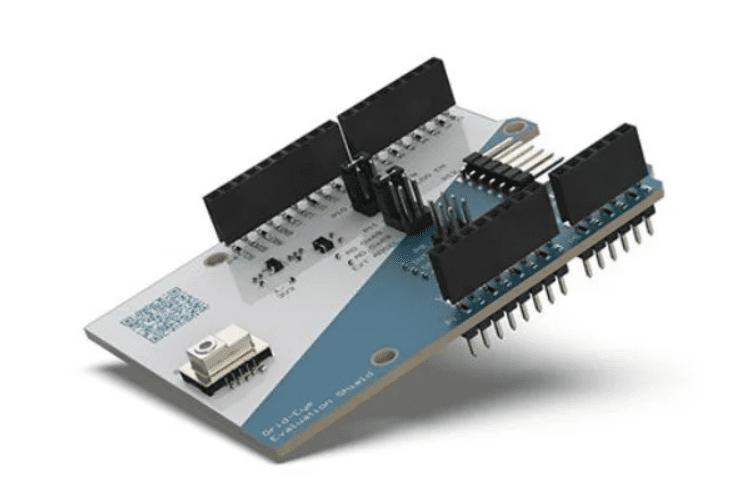TL;DR:
- Panasonic Industry has introduced the Grid-EYE 90° sensor with a wider field of view.
- The new sensor reduces the number of sensors needed for people counting and tracking.
- Privacy-conscious designers appreciate the 64-pixel resolution of Grid-EYE sensors.
- The sensor addresses the need for optimized space utilization in retail, hospitality, healthcare, and lighting industries.
- Machine learning is used to overcome challenges in handling low-resolution infrared data.
- Panasonic collaborates with CN Group to create annotated thermal datasets for improved tracking solutions.
Main AI News:
In a recent development, Panasonic Industry has unveiled the latest addition to its highly acclaimed Grid-EYE sensor family, introducing the Grid-EYE 90° variant. This innovation boasts a 90° lens, significantly expanding its field of view (FoV) and concurrently reducing the number of sensors needed to cover a specific area. The implications of this advancement are profound, as it enables more precise people to count and track applications while also addressing privacy concerns.
Grid-EYE sensors have garnered recognition for their 64-pixel resolution, making them a preferred choice among privacy-conscious designers. With the introduction of the Grid-EYE 90° sensor, these systems are poised for further enhancement, particularly in applications related to monitoring and tracking human movement.
Osamu Mitsumura, Product Manager at Panasonic Industry Europe, highlights the significance of this development, stating, “Knowing where people are is the key to designing a smart space. Today’s industries, particularly those in retail, hospitality, healthcare, and the lighting sector are keen on optimizing the utilization of their spaces. The ongoing pandemic has underscored the importance of effectively managing high-traffic or confined areas, such as offices and public washrooms. Scalability and cost-effectiveness have always been the holy grail of people-tracking and counting solutions, and the Grid-EYE 90° sensor delivers both.”
The Grid-EYE sensor has previously found applications in diverse scenarios, such as identifying hotspots in smart kitchens and regulating air conditioning in specific areas. Additionally, it has been a cost-effective alternative for tracking and counting people, serving as a viable substitute for camera or wireless solutions.
This latest iteration of the Grid-EYE sensor harnesses Panasonic’s extensive expertise in sensing technologies. The incorporation of a 90° wide-angle lens significantly broadens its FoV, surpassing the previous 36° and 60° FoV offered by earlier models. With the Grid-EYE 90°, system designers can now capture the infrared signature of a larger area, reducing the need for an extensive array of sensors. This marks a significant stride in enhancing the efficiency of people tracking and counting devices.
However, successful data acquisition through Grid-EYE is just the initial step in the process of accurately counting people. While standard signal processing algorithms are effective in many cases, they encounter challenges with infrared sensors. Unlike visual spectrum devices, infrared signals can be intricate to handle, especially with low-resolution sensors like Grid-EYE, which are susceptible to noise interference. Everyday occurrences, such as a warm coffee cup, an open window, or an overheating computer, can pose significant challenges in the infrared spectrum, complicating algorithm development.
To tackle this challenge, machine learning (ML) emerges as a promising solution. ML, a subset of Artificial Intelligence (AI), leverages self-learning neural networks to derive insights from input data. By training a neural network with an annotated dataset, it becomes possible to deploy ML models that can handle complex tasks, thus eliminating the need for custom algorithms and costly hardware.
In a strategic move to address the dataset challenge, Panasonic has embarked on a collaboration with CN Group, a software company affiliated with Ciklum. CN Group brings a wealth of expertise in mechanical design, embedded electronics hardware and software, machine learning, and IoT to the table. Together, they are working on assembling datasets that combine visual and thermal information from observed scenes, using Grid-EYE sensors and cameras. Employing computer vision techniques, the dataset is automatically annotated upon detecting humans within the camera’s field of view.
Conclusion:
Panasonic’s Grid-EYE 90° sensor represents a significant advancement in the field of people tracking and counting technology. Its wider field of view and reduced sensor requirements cater to the demands of industries seeking efficient space utilization. The integration of machine learning and the collaboration with CN Group to create customized datasets underscore the potential for personalized solutions. This development positions Panasonic as a key player in the market for smart space optimization and surveillance technologies.

